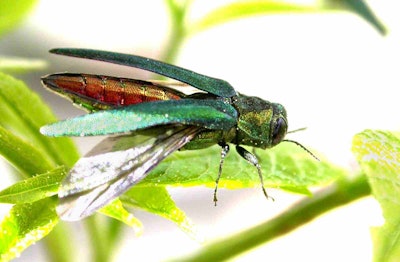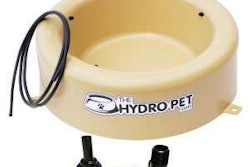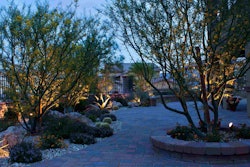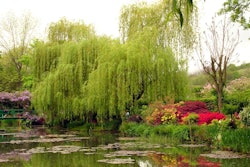 Photo: USDA/Flickr
Photo: USDA/FlickrEver since its discovery in Michigan in 2002, the emerald ash borer (EAB) has become an ever-spreading plague, devastating counties’ ash tree populations wherever it is sighted.
The Asian beetle that has done so much damage has spread to over 30 states now.
While the adults do feed on the ash leaves in the canopy, it is actually the larvae that cause the deterioration that leads to the tree’s inevitable death. As the larvae feed, they chew through the bark and feed on the tissues of the tree creating S-shaped galleries that are a tell-tale sign of their presence.
As the tree slowly starves, the canopy will begin to thin and dieback will occur at the top of the tree. D-shaped exit holes and water sprouts along the trunk are other signs of an EAB infestation in an ash tree. Unfortunately, by the time symptoms are usually noticeable it tends to be far too late for any life-saving treatment for the tree.
Because of the fatal nature of an EAB infestation, there aren’t a lot of options for homeowners or municipalities who have ash trees on their property.
“The biggest thing is for people to be aware – to learn if they have an ash tree, either on their property or near their property – and start thinking about what sort of management they want to do to preserve their tree or remove their trees proactively,” Laurie Reid, assistant city arborist in Charlotte, North Carolina, told WFAE.org.
To help clients who are concerned about EAB, and if you simply don’t have the time to run to every property to confirm who has an ash tree or not, the Colorado State Forest Service and Colorado State University Extension Service have launched a smart phone app that will walk individuals through determining whether their trees are ash species.
The app is free and available for both iPhones and Androids and can be found by searching “ash tree” in the store. Once your client has determined they do have ash trees on their property, you can begin discussing with them what their choices are.
While some have written off pesticide treatments as simply too expensive, recent economic analyses have concluded that treating landscape ash trees with effective systemic insecticides is much less costly than removing them. The tree size, health, location and value should all be considered. The likelihood of success and cost of removing the trees will help your customers decide which choice is wiser for their situation.
Trees that have already lost more than 50 percent of their leaves and branches should be removed and replaced. If EAB infestations have been detected within 10 to 15 miles of your clients’ location, and they don’t want to remove the tree, it is best to start insecticide applications.
If they do end up deciding to treat their trees, there are four main ways to control EAB. The four categories are soil-injected systemic insecticides, trunk-injected systemic insecticides, systemic basal trunks sprays and protective cover sprays.
Imidacloprid, dinotefuran, azadirachtin and emamectin benzoate are all common active ingredients in the various insecticides used to control EAB. Emamectin benzoate can consistently provide two years’ worth of protection with a single application, while trunk injections of azadirachtin can provide one to two years of coverage, depending on the EAB pressure.
Soil applications of imidacloprid and dinotefuran have been found to be more effective when they are applied at the base of the trunk and in the spring rather than the fall.
The timing of applying these insecticides is very important as peak egg hatch and larval establishment occur between early June and mid-August. Because the insecticides are systemic and are transported within the tree, they must be applied before the larvae have been able to successfully disrupt the tree’s phloem and xylem tissue.
Trunk injections are absorbed and distributed through the tree more quickly, taking about one to four weeks, while soil applications can take four to eight weeks and are also advantageous when the soil is excessively wet or compacted.
Basal trunk sprays are quick to apply and don’t wound the tree either, however the sprayers must be calibrated so the proper amount of product is applied to each tree. Protective cover sprays are less common and have limited effectiveness. While intended to target the adult EAB feeding on the leaves, spray drift is common and can harm non-target organisms.
If it is decided that the tree is already too far gone, it is best to remove the tree before it can become a safety hazard. Those who wait run the risk of limbs breaking and harming people or damaging property.
Because EAB can overwinter in the dead wood, individuals are encouraged to use locally sourced firewood, as transporting firewood to other locations can help introduce the beetle to a new area. There are often quarantines set up forbidding the transportation of the infested ash wood.
The wood can be burned, mulched or repurposed into a creative craft, as one Chicago based artist sculpted dead ash trees into chess pieces.









